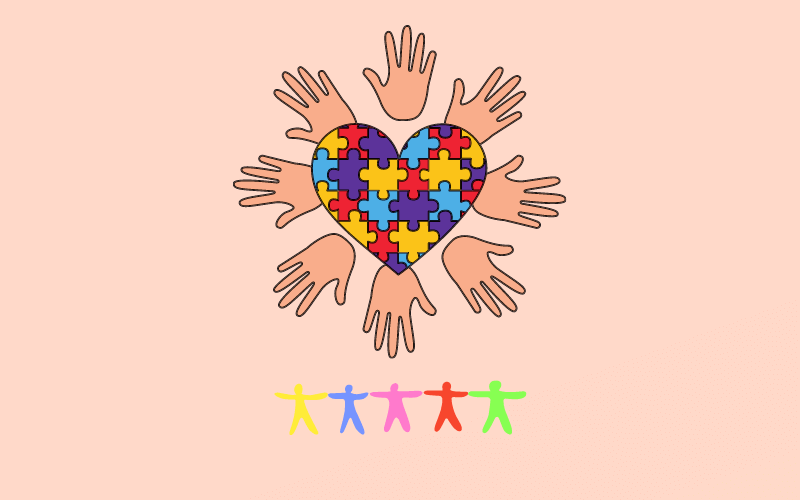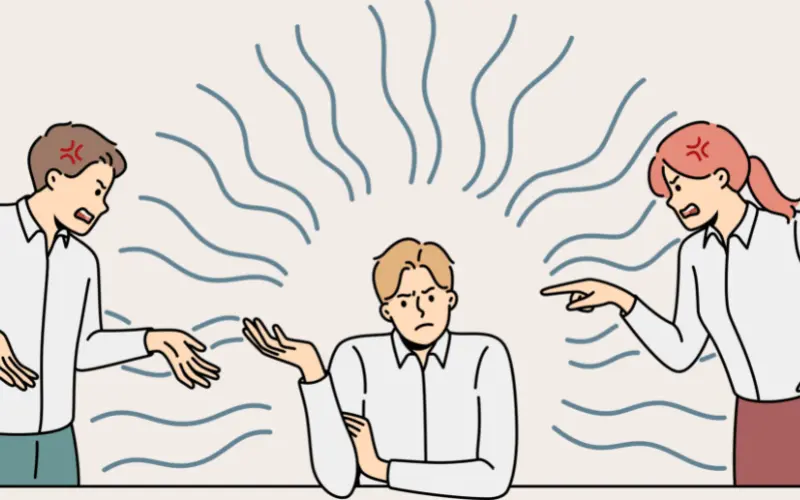If your child has recently been diagnosed with autism, you’re undoubtedly looking for answers to a variety of questions, including what autism is, what are its causes, and how it may be treated.
We know and understand it may be overwhelming to look for the right answers. Here are the questions you’re probably asking yourself right now.
Autism, typically referred to as autism spectrum disorder, is a developmental disorder marked by difficulties in speech, social interaction, and behaviour.
Communication and social interaction difficulties are common in these illnesses. People with ASD frequently have restricted, repetitive, and stereotyped interests or patterns of behaviour. The condition lasts a lifetime, and symptoms differ widely from one individual to the next.
Autism affects how people learn, behave, think, communicate, and interact in different ways than others who do not have the disorder. Because there is so much diversity in the kind of symptoms people experience and the intensity of those symptoms, autism is referred to as a spectrum disorder.
Symptoms of autism
Early childhood symptoms of autism generally develop between the ages of 12 and 24 months. Symptoms may appear at any time.
A significant delay in linguistic or social development may be one of the first signs. Repetitive habits, restricted interests, and social difficulties are all symptoms of autism.
While persons with autism spectrum disorder may not exhibit all of these symptoms, they are likely to exhibit a number of them
Communication and social interaction issues include: Communication problems, such as difficulty communicating feelings, interests, or conducting a back-and-forth discussion
- Making eye contact is difficult.
- Following and participating in conversations is difficult.
- Relationships are tough to form and sustain.
- Nonverbal communication problems, such as difficulty keeping eye contact or interpreting body language.
Patterns of behaviour or activities that are restricted or repetitive include the following:
An increase or reduction in sensitivity to specific sensory information from their environment, such as a negative reaction to a particular sound.
- Sensory sensitivity to stimuli such as taste, sight, and smell.
- Repetitive actions are examples of repetitive movements, motions, or speech patterns.
- People attempting to get their attention are met with a slow or unresponsive reaction.
- Strict devotion to a set of habits or procedures.
- Stumbling blocks (i.e., self-stimulating, repetitive actions such rocking, walking on toes, or flapping hands).
It’s crucial to remember that because autism is a spectrum disorder, persons might have mild, moderate, or severe symptoms. Some people may have a variety of symptoms, but only feel them to a minor degree. Within each category, individuals are assessed and the severity of their symptoms is documented.
To be diagnosed with ASD (Autism Spectrum Disorder), a person must have all three of the first group’s symptoms and at least two of the second group’s symptoms.
People may only have a few symptoms in important areas yet suffer substantial impairments as a result of those symptoms in other situations.
Milder autistic symptoms allow people to operate in everyday life, but they are more prone to suffer from additional mental health difficulties such as excessive stress, compulsive behaviours, sensory issues, anxiety, and depression.
Autism is most commonly diagnosed in children, although it may affect individuals from various walks of life, races, and ethnicities.
Read : How to Manage Children With Autism Spectrum Disorders?
Diagnosis
Parents are often the first to detect signs of autism, but other caregivers, teachers, and physicians may also notice them.
The importance of early screening and evaluation cannot be overstated. If you are worried about your child’s conduct, you should speak with his or her doctor. The earlier a diagnosis is determined, the earlier treatment may begin.
There is no precise test that can be used to establish whether or not a person has autism. Doctors can diagnose autism by observing behaviour and asking developmental questions.
Evaluations
Doctors track a variety of developmental milestones and evaluate for various forms of developmental delays during routine developmental checks throughout infancy. When children fail to reach specific milestones, they may be subjected to further testing.
A panel of professionals, including a developmental paediatrician, a child psychiatrist, and a speech-language pathologist, will examine a variety of items during an additional examination, including age-appropriate behaviours, cognitive capabilities, and linguistic abilities.
The following are some examples of tests that may be used in the diagnosis of autism:
- Questionnaires on autism symptoms.
- Monitoring the progress of the child.
- Hearing evaluations.
- Tests of intelligence.
Diagnosis for adults
Autism is most commonly diagnosed in early infancy, although it can also be detected in adolescence and maturity. Because certain symptoms of autism can be mistaken with other mental health problems such as anxiety, OCD, and ADHD, diagnosing autism later in life can be more challenging.
While experts are currently researching the best therapies for people with autism, having a diagnosis might help you understand your present and prior challenges. It can also assist you in recognising your abilities and obtaining assistance in areas where you may be struggling.
Although early detection is preferable, it is never too late to be assessed, diagnosed, and treated for autism. If you’re having symptoms that might be connected to autism, speak with your doctor to find out more.
Causes
While the specific reasons are unknown, research shows that the disease has a hereditary component. Studies demonstrating that children who have a sibling with autism are at a greater risk of developing autism themselves hint to a genetic link.
However, only around 20% of the cases can be traced back to hereditary factors, according to studies. To further understand how particular genetic mutations or variants may contribute to the development of autism spectrum disease, more study is needed. While genes are considered to play a role, studies have also connected preterm delivery and advanced paternal age to the development of autism.
Types of autism
When a person is diagnosed with autism, their functional level is also determined. Autism spectrum disorder is divided into three levels:
Level 1: Exceptional performance Autism Spectrum Disorder (ASD) Level 1 is a moderate version of the disorder. People with this personality type may struggle with social connections and engage in restrictive activities. They typically only require minor assistance to go about their everyday lives.
Level 2: Severe but not life-threatening Level 2 autism spectrum condition requires further assistance. Their social issues are obvious, they may have communication difficulties, and they may require support in managing troublesome behaviours.
Level 3: Severe Level 3 autism causes symptoms that make it difficult for people to live and function independently. People with this degree of autism are generally unable to communicate verbally, have difficulty adapting to change, engage in repetitive or restricted activities, and are hypersensitive to sensory inputs.
These levels are used to represent the severity of the impact on behavioural and social skills.
The Diagnostic and Statistical Manual of Mental Disorders (DSM) was published in 2013, and it represented a fundamental shift in how autism was categorised and diagnosed. Experts used multiple terms for different kinds of autism until the DSM-5 was published. These included the following:
- Asperger’s syndrome is a milder type of autism characterised by normal intellectual functioning but social interaction difficulties.
- PDD-NOS (pervasive developmental disorder, not otherwise defined) was a milder type of autism than Asperger’s syndrome.
- Autistic disorder was a more severe type of autism than Asperger’s and PDD-NOS, with more severe impairments.
These disorders are now referred to as autism spectrum disorder. While the following categories are no longer recognised diagnoses, they are nevertheless used by some people to describe how symptoms are felt and how severe they are. Asperger’s syndrome, for example, is frequently used as a self-identity or to connect with others who have similar experiences.
Treatment
While autism is a lifelong disorder, there are therapies that can alleviate many symptoms and enhance people’s capacity to function in many areas. Treatment should begin as soon as feasible after a diagnosis, according to the National Institute of Mental Health.
Many therapeutic options include treatments like:
- Behavioral treatment
- Play therapy treatment
- Occupational treatment
- Physical therapy
- Speech therapy
Massages, weighted blankets and clothes, and meditation practises can all help to calm the body and mind. Treatment outcomes, on the other hand, will vary.
There is no one-size-fits-all therapy. Because people with autism have a wide variety of symptoms, each person’s requirements are unique.
Medications
While no medicine has been authorised to treat autism, a doctor may prescribe some medications to help with certain symptoms.
Selective serotonin reuptake inhibitors (SSRIs), antipsychotics, stimulants, anti-anxiety medicines, and anticonvulsants are some of the pharmaceuticals that can assist with symptoms like:
- Aggression
- Anxiety
- Attention problems
- Depression
- Hyperactivity
- Inappropriate speech
- Irritability
- Social withdrawal
Parents and caregivers should evaluate the research and financial expenses against any potential advantages before investing in any of them. Find out more about autism therapies that aren’t traditional.
Behavioral and Developmental Treatment
Behavioral, psychological, and skill-training treatments are frequently used in autism treatment. Applied behaviour analysis (ABA), a type of treatment that uses reinforcements to teach and reinforce desired behaviours and abilities, is a prevalent method. The following are some of the most frequent treatments used to treat autism:
- Developmental and individual differences relationship therapy
- Early intensive behavioral intervention
- Pivotal response therapy
- Relationship development intervention
- Verbal behavior therapy
- Cognitive-behavioral therapy (CBT)
These therapies are intended to assist persons with autism spectrum disorder in achieving the following goals:
- Enhance your cognitive talents
- Enhance your current abilities.
- Improve your language and communication abilities.
- Enhance your social abilities
- Learn adaptive skills that will help you live independently.
Assistive technology, speech therapy, occupational therapy, and social skills training are some of the other therapies that may be employed. Treatment frequently includes caregiver training, in which parents and other caregivers learn techniques to assist them reinforce what is being worked on in treatment.
Coping
There are a variety of self-help methods that you may employ in addition to getting professional therapy to help you manage with some of the symptoms of autism. There are a few things that can help:
- Acceptance is key.
- Maintain A Routine
- Create a relaxing and welcoming atmosphere
- Acquire the Ability to Recognize Triggers
- Participate in a Support Group
- Keep an eye out for nonverbal communication
- Positive reinforcement should be used
Conclusion
Autism does not have cures and is a complicated illness that can produce varying degrees of impairment and have a wide range of effects on a person’s life. Early and intense behavioural interventions are the most successful therapies. The earlier a youngster is engaged in these programmes, the greater his or her chances are of succeeding. Finding the proper therapy for yourself or a loved one might help them become more self-sufficient and live a happier life. Remember that autism is a complicated condition, and it might take time for someone with ASD to discover the right programme for them.











